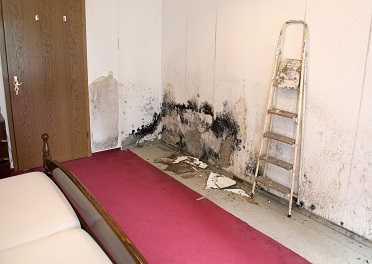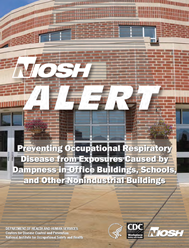INDOOR ENVIRONMENTAL QUALITY
Dampness and Mold in Buildings

Dampness results from water incursion either from internal sources (e.g. leaking pipes) or external sources (e.g. rainwater). Dampness becomes a problem when various materials in buildings (e.g., rugs, walls, ceiling tiles) become wet for extended periods of time. Excessive moisture in the air (i.e., high relative humidity) that is not properly controlled with air conditioning can also lead to excessive dampness. Flooding causes dampness. Dampness is a problem in buildings because it provides the moisture that supports the growth of bacteria, fungi (i.e., mold), and insects.
In the presence of damp building materials the source of water incursion is often readily apparent (e.g., leaks in the roof or windows or a burst pipe). However, dampness problems can be less obvious when the affected materials and water source are hidden from view (e.g., wet insulation within a ceiling or wall; excessive moisture in the building foundation due to the slope of the surrounding land).
Spotlight
NIOSH Alert: Preventing Occupational Respiratory Disease from Exposures Caused by Dampness in Office Buildings, Schools, and Other Nonindustrial Buildings

Office buildings, schools, and other nonindustrial buildings may develop moisture and dampness problems from roof and window leaks, high indoor humidity, and flooding events, among other things. For this Alert, we define "dampness" as the presence of unwanted and excessive moisture in buildings [AIHA 2008]. This can lead to the growth of mold, fungi, and bacteria; the release of volatile organic compounds; and the breakdown of building materials. We use the term "mold" for a group of fungi that are common on wet materials. Outdoors, molds live in the soil, on plants, and on dead or decaying matter. There are thousands of species of molds and they can be any color. Different mold species can adapt to different moisture conditions. Research studies have shown that exposures to building dampness and mold have been associated with respiratory symptoms, asthma, hypersensitivity pneumonitis, rhinosinusitis, bronchitis, and respiratory infections. Individuals with asthma or hypersensitivity pneumonitis may be at risk for progression to more severe disease if the relationship between illness and exposure to the damp building is not recognized and exposures continue.
NIOSH Alert: Preventing Occupational Respiratory Disease from Exposures Caused by Dampness in Office Buildings, Schools, and Other Nonindustrial Buildings
DHHS (NIOSH) Publication No. 2013-102 (November 2012)
- Page last reviewed: May 17, 2013
- Page last updated: October 31, 2013
- Content source:
- National Institute for Occupational Safety and Health Respiratory Health Division


 ShareCompartir
ShareCompartir